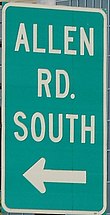Allen Road
The Spadina was proposed in the 1950s as a north–south freeway, intended to connect downtown Toronto to the suburbs of North York and to serve the Yorkdale Shopping Centre project; it was only partially built before being cancelled in 1971 due to public opposition.
[3] Allen Road begins at Eglinton Avenue West with two separate signalized intersections serving the opposing directions of travel on the expressway.
Similarly, two lanes are provided southbound over Highway 401, and access from the eastbound and westbound 401 merges with the Allen south of Yorkdale Road.
[10] Road Emergency Services Communications Unit (RESCU) cameras are found on the roadway in nine locations:[11] The Spadina Expressway was one of several intraurban freeways proposed in the 1950s to crisscross Toronto.
[citation needed] The 1969 functional design proposed an express route in the centre of Spadina Avenue, and parallel two-lane service roads on either side to provide access to properties.
The routes of the Lakeshore and Don Valley expressways were less controversial and allowed to proceed, while others were put off for further study, as they would cut through developed areas and were considered lower priority.
[30][31] The Roads Committee turned down their requests, and York Township threatened to go to the Supreme Court of Canada to block Metro from taking their park.
University of Toronto professor James Acland of the Rathnelly Residents Association spoke of the futility of combining rapid transit and expressways on one route.
"They won't persuade anyone to park his car and take rapid transit when there is a wonderful expressway inviting him to drive downtown.
"[34] S. A. Hudson, president of the Lawrence Heights Ratepayer Association, cited figures showing the roadway would carry 10,000 vehicles into the core at rush hour, requiring 69 acres (28 ha) for parking alone.
The province wanted Metro council approval for the whole project before releasing any funds, but the vote covered only the Lawrence to Highway 401 section.
Transportation minister William Goodfellow wrote to council to state that since Metro had not voted to approve the entire project, the province would not consider connecting Spadina with Highway 401.
[38] On February 19, 1962, Metro Roads Committed approved the whole project by a 5 to 1 vote, the only dissenter being future Toronto Mayor William Dennison.
Metro, which was also constructing the Gardiner Expressway, Don Valley Parkway and Bloor–Danforth subway lines had fallen under the scrutiny of the Ontario Municipal Board (OMB) over its spending.
[49][50] Notable among the opposition was urban theorist Jane Jacobs, who moved to the Annex in 1969, fresh from a battle to stop the Lower Manhattan Expressway in New York City.
In an age of software Metro planners treat people like hardware — they haven't the faintest interest in the values of neighbourhoods or community.
[49] Members David and Nadine Nowlan, professors at University of Toronto, released their book The Bad Trip, an economic analysis of the project and explanation of their opposition.
Opposition groups banded together under the banner of "The Spadina Review Corporation" and hired one of Canada's top trial lawyers, John Josiah "J.
Council was represented by its solicitor and its witnesses included Metro and City Commissioners and American transportation planner Alan Voorhees.
[58] Opposition groups based their case on the factors of noise, pollution, destruction of homes and the expected increase of traffic the roadway would cause.
Their witnesses included Jack Fensterstock of the New York City Department of Air Resources,[59][60] neighbourhood residents, as well as urban planners, economists and architects.
Speaking in the Ontario Legislature, Davis said: If we are building a transportation system to serve the automobile, the Spadina Expressway would be a good place to start.
"It's shocking that a group who never at any time suggested workable alternative routes has successfully opposed something as important in the growth of Metro as was the Don Valley".
[67] In the opinion of critics, the move set "in motion a trend that has yet to abate: politicians overruling the painstaking work of urban and transportation planners".
The Spadina subway line, designed by the transportation planners within the median of the expressway, has been criticized as the "worst place to put that route ...
Esther Shiner, who lived near the Lawrence intersection, was elected to North York Council in 1973 on a platform to get the expressway completed to Eglinton Avenue.
[69] She headed the "Go Spadina" public campaign that was successful in persuading Metro, against the wishes of the City of Toronto, to pave the ditch and open the road to Eglinton on September 8, 1976.
[70][71] In response, Davis made plans to transfer a strip of land south of Eglinton to the City of Toronto to block any further extension.
Metro and the province ended their dispute in an agreement to build the Black Creek Drive arterial road, a southerly extension of Highway 400.
Unlike the Don Valley Parkway and Gardiner Expressway, exits along Allen Road are not numbered and are identified by street name.





